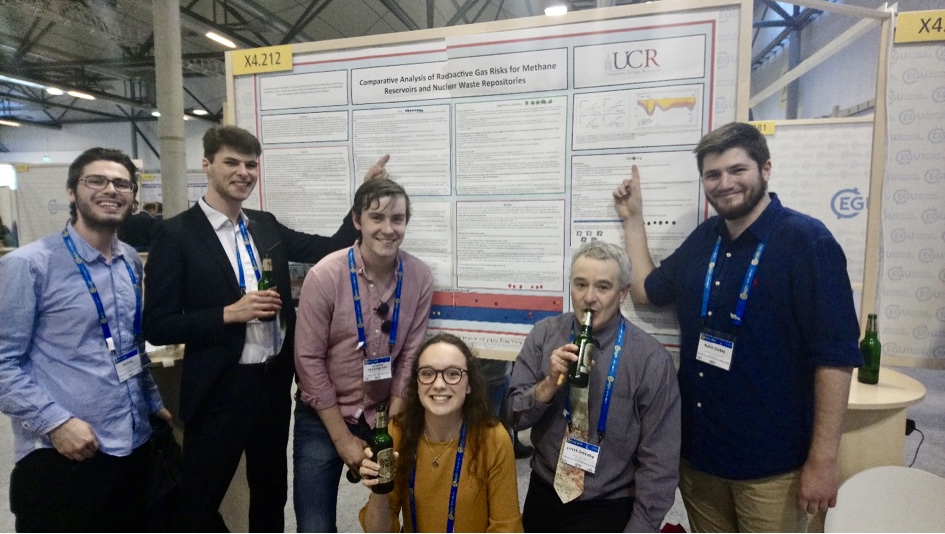By Julie de Groot
I think I can safely say that the best part of the Earth Science track at UCR is the fieldtrips. Going to the Ardennes in Belgium in the 100 level, and to the Eifel in Germany in the 200 level was absolutely legendary, but nothing tops the amazing opportunity we got this semester in the 300 level, namely attending the EGU (European Geosciences Union) conference in Vienna. Robin Colbey, Ilir Deva, David Douw, Femke Keij, Lourens van Langeveld, Sven Arne Quist, and I represented our class with two life-size posters, compiled from our individual research papers regarding the assigned topics “Comparative Analysis of the Biohazard Risk Management challenges for Nuclear and Electronic Waste”, and “Comparative Analysis of Radioactive Gas Risks for Methane Reservoirs and Nuclear Waste Repositories”. Of course, this all happened under the strict supervision of Dr. Joseph Resovsky.
Even though going to Vienna for a conference is a very high-class experience, we are still students, so five of us started our adventure on Wednesday with a 17-hour bus ride from Amsterdam. Luckily we were able to occupy the backseats of the bus, which meant we could alternate between not one, but two, shoulders to sleep on. It was as comfortable as a Flixbus can be, and if you forget about the part where there was a filthy man sitting in front of us leaving a whole patch of body grease and sweat on the window, and the part where the police searched us for illegal substances, it was a pretty smooth trip.
We arrived Thursday at noon and were immediately amazed by the beauty and grace of the city, particularly the rocks that the city was built of. Happy to stretch our legs, we headed like real urban rangers to what we thought was the conference building (but not quite yet) so we could register and pick up our free travel pass. On our way, we discovered some beautiful ammonites in the freshly polished floor of the bank where we went to get some cash. I bet you can imagine the facial expression of the employees when they suddenly saw six students crawling over their floor – so much for being passionate! We took the underground to the National History Museum, which allowed us to release our inner rock hunters with its amazing collection of rocks, minerals, and fossils. Later that night we welcomed Dr. Resovsky at our hostel with ‘some’ beer, glad to see he made it too. The bed was a lot more comfortable than the bus, so the next morning we woke fresh as a mountain stream and shining bright like diamonds, ready for the EGU conference.

For most of us it was our first conference, ever, and especially of this scale, and there being over 15,075 visitors from 106 different countries was definitely impressive. Even though our posters were two out of many hundreds, we were able to discuss them and engage with people passing by (David’s appearance particularly was rock solid, and made a great impression). Some people really challenged us by asking specific questions, some gave suggestions, some were surprised, but all of them were nice and supportive of our work. As undergraduate students we were very much in the minority, and most participants were a couple of stepping stones further ahead in their academic career, which was noticeable from the advanced discussions and debates that were taking place around us.
All of us took some time away from our poster to explore and learn about all the things other researchers had done. It was amazing to experience how broad the field of earth science is, and to get a grasp of all the overwhelming amount of research that was going on. Scattering over the different buildings, rooms with oral presentations, and poster halls, we all made personal discoveries, whether it was learning about the modeling of climatic impacts on forest ecosystems, meeting the weather forecaster and cryosphere researcher at the NOS, or chasing after the god of seismic interferometry. It was very interesting to meet the people behind the knowledge that we as students gather from the articles and papers of various research databases, and personally, the experience made me very motivated and excited for the future.
Although we tried, it was impossible to process all the information, and the day ended way too soon. Tired of the intellectual stimulation, we all headed back over the mountains, some of us with a one-and-a-half-hour flight, others with another seventeen hour bus drive, accompanied by maybe the only other Irish paleontologist who isn’t David, and some partying bachelorettes. All in all, it was an amazing and valuable experience in a beautiful city, full of excitement, interesting people, great company, and worth every hour!
Julie de Groot is an Earth Science, Biology and Life Science Major from Sittard, the Netherlands.

